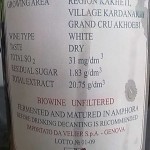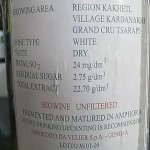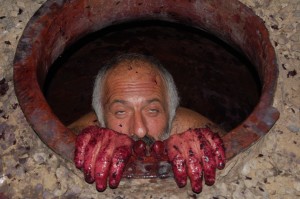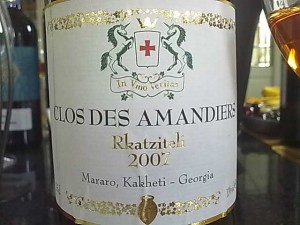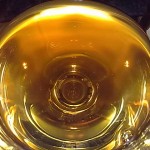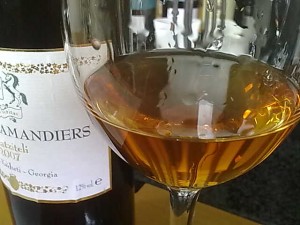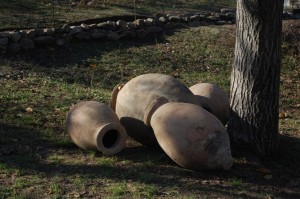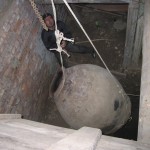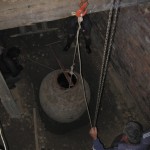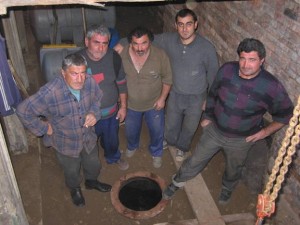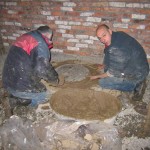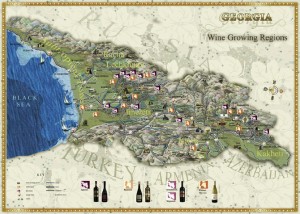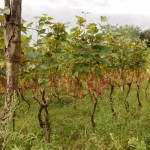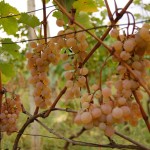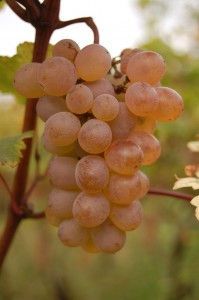Aug 15, 2010
Welcome (Back) to Georgia Part III – Prince Makashvili Cellar

- Prince Makashvili Cellar – Soliko Tsaishvili, here Irakli Pruidze & David Kapanadze
Date tasted: July 11th, healing 2010 13:45
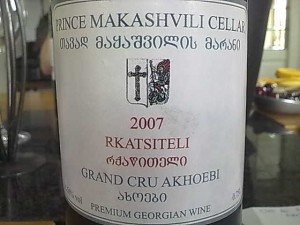 This grapes for this wine come from the Grand Cru vineyards of Akhoebi, in the village of Kardanakhi in the low hills of the Kakheti region. The vineyard covers 1.9 HA and are farmed biodynamically and harvested by hand. The soil is black and carbonate-rich. The vines are widely spaced at approximately 2500 plants/HA, trained in a double Guyot pattern. The vineyard is planted with approximately 90% Rkatsiteli, 4% Mtsvane, 4%Khikhvi and a red variety called Saperavi, all on original (non-American) root stock. Harvest is done by hand, the grapes pressed softly. The wine is spontaneously fermented and macerated for 6 months with skins in Qvevri. After skin and stalk separation, the resulting wine is stored in smaller Qvevri for a further 12 months. Bottled without filtration. In 2007 approximately 20hl/ha was produced, or 1200 bottles.
This grapes for this wine come from the Grand Cru vineyards of Akhoebi, in the village of Kardanakhi in the low hills of the Kakheti region. The vineyard covers 1.9 HA and are farmed biodynamically and harvested by hand. The soil is black and carbonate-rich. The vines are widely spaced at approximately 2500 plants/HA, trained in a double Guyot pattern. The vineyard is planted with approximately 90% Rkatsiteli, 4% Mtsvane, 4%Khikhvi and a red variety called Saperavi, all on original (non-American) root stock. Harvest is done by hand, the grapes pressed softly. The wine is spontaneously fermented and macerated for 6 months with skins in Qvevri. After skin and stalk separation, the resulting wine is stored in smaller Qvevri for a further 12 months. Bottled without filtration. In 2007 approximately 20hl/ha was produced, or 1200 bottles.
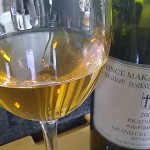 Appearance: Apricot-orange hued with golden edges.
Appearance: Apricot-orange hued with golden edges.
Nose: Herbs and spices (lavender & rosemary) layered on top of yellow fruit. Sweet arctic cloud berries with strawberry (yes, strawberry) notes.
Palate: Great focused fruit. Apricots mostly. Medium tannins with medium level acidity. 30+ second finish. Bone dry.
The Grand Cru Akhoebi was my favorite of the three I wines tasted.
Date tasted: July 11th, 2010 13:45
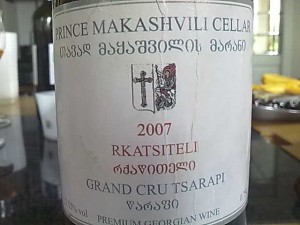 This grapes for this wine come from the Grand Cru vineyards of Tsarapi, in the village of Kardanakhi. The vineyards cover 1.25 HA and are farmed biodynamically and harvested by hand. The wine is spontaneously fermented and macerated for 6 months in Qvevri, then stored in the Qvevri for a further 12 months. Bottled without filtration, and on this particular bottle, this was quite obvious. Approximately 20hl/ha is produced, or about 1200 bottles.
This grapes for this wine come from the Grand Cru vineyards of Tsarapi, in the village of Kardanakhi. The vineyards cover 1.25 HA and are farmed biodynamically and harvested by hand. The wine is spontaneously fermented and macerated for 6 months in Qvevri, then stored in the Qvevri for a further 12 months. Bottled without filtration, and on this particular bottle, this was quite obvious. Approximately 20hl/ha is produced, or about 1200 bottles.
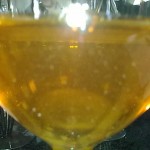 Appearance: Darker and more copper-hued with loads of visible sediment 🙂
Appearance: Darker and more copper-hued with loads of visible sediment 🙂
Nose: Sponty aromas with apricots, with less herbs and spices than the Akhoebi Grand Cru. My favorite on the nose of the three wines because it had that perfect balance between fruit and wild aromas with just enough minerals to give the wine a serious edge.
Palate: More vinous than the Akhoebi – thick, structured and concentrated. Quite a serious wine and very mineral. Medium + tannins and acidity with a long finish. Bone dry, elegant fruit.
This wine wanted desperately to be my favorite, but it came in second behind the Akhoebi. However, with a few years more of cellaring, this may show even better than the Akhoebi.
My overall impressions were that these three Georgian wines I tasted were of top quality and quite serious food wines. I would have no problem drinking them alongside my Friulian & Slovenian favorites.
